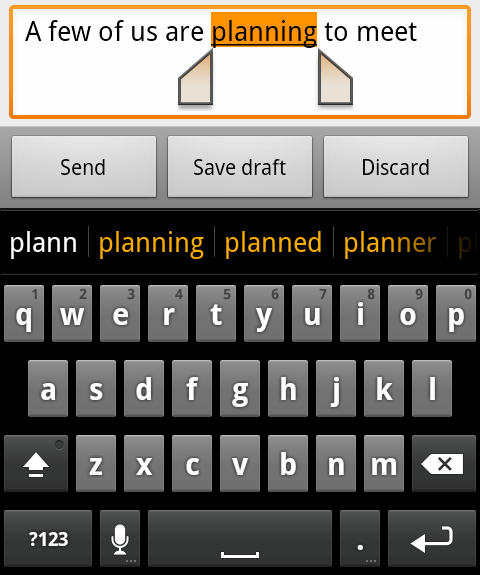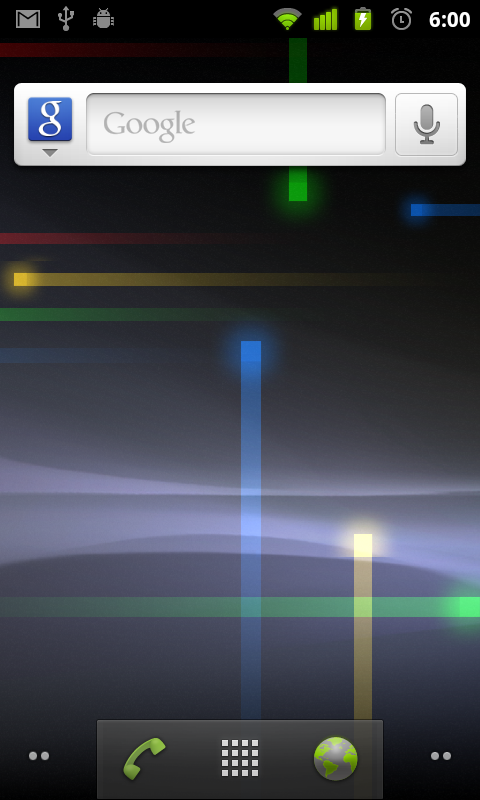A Busy Day for Android - Nexus S and Gingerbread (2.3) Officially Announced
by Brian Klug on December 6, 2010 9:35 PM EST- Posted in
- Smartphones
- Nexus S
- Android
- Mobile
What's new in Android 2.3
As expected, today Google announced Android 2.3 Gingerbread and the Nexus S. Android 2.3 is the latest iteration of Google’s popular smartphone platform, and includes a number of immediately apparent graphical changes to the Android 2.2 UI, and a host of under the hood features for developers. Alongside the Android 2.3 announcement came official confirmation of the Nexus S, which appears to be architecturally very similar to the Samsung Galaxy S line of devices, with the notable inclusion of near field communication (NFC) hardware, a curved display, and a front facing camera.
First up are new user features in Android 2.3, which there are a number of. Most notable among those are a host of UI changes which google claims are aimed at improving both speed, look, feel, and simplicity. The grey shade and notification bar is now solid black, and menu options appear to be either white or green on black. No doubt, this is done intentionally to help Android 2.3 finally leverage power savings of black (off) pixels on devices with AMOLED displays. There are additional changes in the settings application to make navigation easier, though it isn't immediately obvious what those changes are. Gingerbread’s UI brings GPU accelerated animations onboard and will likely provide some speedup to the interface which even with 2.2 was occasionally jittery even on the fastest hardware.
Gingerbread also brings a multitouch virtual keyboard with repositioned and reshaped keys for better targeting at high speeds. Multi-touch support on Gingerbread enables input such as shift+<letter> and ?123+<symbol>, long-press to select accented characters (which sounds almost identical to iOS's implementation) and of course just general accuracy improvement. Though most of the commercial platforms bundle Swype or a multitouch keyboard rolled by the device OEM (such as the Droid X and Droid 2), it's nice to see stock Android finally getting a better keyboard.

Along those lines also is improved word selection and one-touch copy-paste support. Press-holding on a word selects for copy and paste, and also enables free-selection mode which brings up handles for selecting much more text, which looks very similar to iOS' copy paste implementation. No trackball or cursor is needed in either selection or cursor mode, which is nice for devices (like the Droid X) which lack a trackball.


There are also improvements to power management and applications control. It's noted that the system now has the power to manage applications - even closing them if necessary - to ensure maximum battery life. From the screenshots provided, it appears that Gingerbread now provides a graph of charge and elapsed power-on time, as shown above. Note how directly below the graph is a timeline of screen-on events (shown with blue) and charge events (shown with a green highlight). It's nice to see users being given some more direct feedback to manage power consumption. Notably, this UI appears very similar to System Panel, an application I have running on all the Android devices that I come across.
There's now a link to the manage applications setting window from the options menu on the home screen. No doubt Google views applications manager as the built in task manager for Android (which it basically has been since day one) and wants people to use these tools to manage active applications and see memory footprint instead of third party task managers.

Gingerbread also adds SIP support for VoIP and internet based calling. Like other SIP supported devices, you need a SIP account and provider of your own, but that's nothing new if you're coming from a SIP-friendly platform.

The big thing Google has added support for is near-field communication (NFC) which enables the device to read information from smart tags and stickers. I'm left thinking that NFC is designed to augment and replace QR codes in the long term. NFC in general has a maximum bit rate of around 424 kbps/s and range of under 0.2 meters, though it's unclear what real-world performance and range will be for NFC tags and readers in smartphones. Expect to see a wave of NFC-enabled devices from RIM, Nokia, and even Apple.




















45 Comments
View All Comments
Trefugl - Tuesday, December 7, 2010 - link
If you're going to blow $600 on a phone, then why should you need carry around two devices?I would expect my relatively expensive devices to meet my (reasonable) storage requirements either natively or via expansion. I'm not ticked that it's not an option here, but it does affect my decision and I'm leaning elsewhere a little more now.
Bhairava - Tuesday, December 7, 2010 - link
Of course no one is forcing me, dude....but the lack of microsd slot still sucks. Android terminal are better beacouse you can do whatever you want (change battery, expanding storage etc), opposite to the iPhone crap that allows you nothing.Now this is the first step into the wrong Apple-like direction.
Cbac - Tuesday, December 7, 2010 - link
Am I missing something? It sounds like the Nexus S doesn't have a microSD card but is there a reason to think that future native 2.3 phones won't have them either? My impression was that the Nexus One wasn't really all that good of a phone vs. manufacturer/carrier specific models but was appreciated in that you got updates much quicker. Why are people talking about a lack of an SD card on this google phone like it's setting the stage for all the others? I mean don't we know that it's already lacking vs. others in that it's not one of the dual core chips we were expecting? Why should it be any different in respect to the lack of an SD slot?Zoomer - Wednesday, December 15, 2010 - link
Not sure what you are talking about since the Nexus One is a very good device when it came out. Obviously it doesn't beat devices that just came out, but what can?I believe it holds its own even amongst newer devices.
Disclaimer: HTC Desire owner
Why is there a larger form factor, but with the same screen res, less expansion capabilities? The concave thing seems like a gimmicky waste of space.
And I can't believe it doesn't support GSM video calling.
Jodiuh - Monday, December 6, 2010 - link
I'm looking @ a Fascinate right now and it's most certainly not 4" tall.Brian Klug - Monday, December 6, 2010 - link
Samsung lists the following dimensions for the Fascinate: 4.18” x 2.5” x 0.39” here: (add http) samsung.com/us/mobile/cell-phones/SCH-I500RKAVZWI'll have to double check the unit I still have in a second, but I believe the Fasciante is indeed just over 4" tall. ;)
-Brian
craig0ry - Monday, December 6, 2010 - link
I'm curious as to why you think they released this specific hardware configuration, as opposed to waiting for dual-core right around the corner, not to mention the Bluetooth 2.1+EDR... This being the "developer" phone for the Android platform, I'm a little confused as to why they would release this seemingly incremental update versus what waiting for what is sure to be a major revolution for the platform...Any idea what the plan is here with this specific kit?
TareX - Monday, December 6, 2010 - link
Exactly. Let's not fool ourselves: This is a Samsung Galaxy S, with a flash, and a new chip with 0 significant uses.... minus the microSD expansion.ssj4Gogeta - Tuesday, December 7, 2010 - link
Don't forget the curved screen :-Pstrikeback03 - Tuesday, December 7, 2010 - link
Listening to their interviews, it sounds like they use these reference devices in designing the OS. So Google has probably had these around for months, and probably didn't want to wait to have next-gen SoCs before they could make serious progress on the OS. Which could also help explain why they showed off a tablet running Honeycomb at the same time they announced Gingerbread, we might see that even more quickly than the usual gap between version releases for Android.